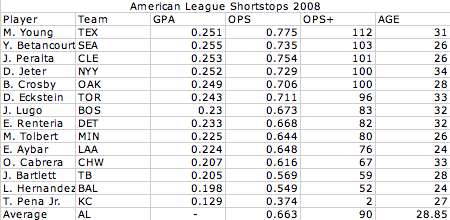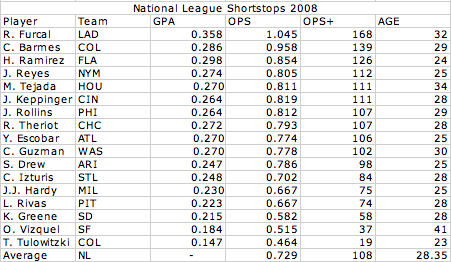Can you name the top three hitting shortstops in the AL at the moment? Derek Jeter? Nope. Micheal Young, sure, he's number one. Orlando Cabrera? Nyet. Edgar Renteria? Sorry. Bobby Crosby? Nada. No, the second and third best hitting shortstops (by OPS+) in the American League this year have been Jhonny Peralta and Yuniesky Betancourt. And they haven't really been that good. Meanwhile the National League is blessed with a plethora of talented players manning the hole. Hanley Ramirez and Jose Reyes are two of the best young players in the game, Jimmy Rollins won the NL MVP last year, Rafael Furcal is having an otherwordly season, and so on. Today most of the best shortstops in baseball - the elite guys, the good middle tier, and everyone else - play in the National League. In fact, the difference between the two leagues has been monumental. By about any measure - Win Shares, OPS, OPS+, GPA, RC - the NL shortstops are playing much better than the AL shortstops.
So sure, the NL has a couple of good shortstops, but so does the AL. Maybe this is just a weird fluke. Well, I've fixed up a chart with the hitting data of the shortstops who have played the most games for his team so far this year. Check out the differences between the two crops of shortstops.


As you can see, the difference in the raw data is pretty large - .70 points of OPS. When you consider that, by all popular accounts, the American League is far superior to the NL, this disparity is even more shocking.
A few notes: Minnesota and Baltimore have both used a couple of shortstops but their lines aren't radically different (and I'm more interested in the players themselves than the position, if that makes sense). In the NL both Tulowitzki and Barmes are included for Colorado since their playing time is about equal, and its seems wrong to leave one out. Keppinger gets the nod over Hairston in Cincy (though they are both playing very well in fairly equal time), and Jack Wilson has been injured all year so Luis Rivas is counted in Pittsburgh. Oh, and Old Man Vizquel is clearly the starter in San Fran, so I've included him (more on this later). Defense is, alas, left by the wayside here, but I don't think that it changes the general thrust of the situation.
The difference in production between the two leagues so far been about the same as the difference between the career numbers of Vernon Wells and David Eckstein. To be fair, the National League has also actually been the better hitting league so far this year, pitchers and all, though not by a gigantic amount, and OPS+ is league and park adjusted. Still, the current NL crop of shortstops are far outhitting their AL counterparts. Looking at OPS+, the 10 best shortstops in the league this year have been Rafael Furcal, Clint Barmes, Hanley Ramirez, Jose Reyes, Micheal Young, Miguel Tejada, Jeff Keppinger, Jimmy Rollins, Ryan Theriot, and Yunel Escobar. The results are pretty much the same if you look at GPA and RC. One of of those ten players plays in the American League. Statistics aside, its not hard to argue that most of the players are much better than the current crop of AL shortstops. I mean for crying out loud, Tony Pena Jr. starts at short for an AL team!
Compounding the National League's advantage is that NL shortstops, are on the whole, younger than their counterparts. The average NL starting shortstop is about half a year younger than the average AL starting shortstop, which is significant but not substantial. If we don't include Omar Vizquel, however, the average age of National League shortstops drops by another .8 years, making the average, non-Omar Vizquel shortstop in the NL 27.56 - 1.3 years younger than in the AL. Whats more, if you were to draw a list up of starting shortstops 25 and under you'd get Tulowitzki, Reyes, Ramirez, Yunel Escobar, Stephen Drew and J.J. Hardy in the NL, and Eric Aybar and Luis Hernandez of the Orioles in the AL. I know which group I'd prefer. All this suggests that the NL will be the better league for shortstops going forward as well, possibly even more so, and in a hurry. To be fair, many of the best shortstop prospects play for AL organizations - Mike Moustakas (Royals), Elvis Andrus (Rangers), Reid Brignac (Rays), Carlos Truinfel (Mariners), Jed Lowrie (Red Sox), so the NL's current domination might not last forever, though it seems pretty entrenched for the next three to five years.
How did we get here though? It was only a couple of years ago people were talking about how the American League had one of the best crops of shortstops of all time, with Alex Rodriguez, Derek Jeter and Nomar Garciaparra. Throw in Miguel Tejada and you had a veritable pantheon of young middle infielders. Well, today A-Rod plays third, Nomar is injured and not a shortstop anymore, Jeter is still chugging along but, at 34, not getting any younger (or better), and Tejada, much older and perhaps wiser, is plying his trade in the National League. The most significant shortstop to be developed by an American League organization over the last five years is Hanley Ramirez, and he was traded before he got going. Other young also rans include Bobby Crosby was once promising but now fairly average, and Jhonny Peralta and Yuniesky Betancourt who are, as mentioned, average at best hitters. The reality is that shortstop in the American League has been a stagnant positions for the last five years. Young, Jeter and Tejada and Carlos Guillen are the only AL shortstops to have participated in the All Star Game since 2003, when A-Rod and Nomar played, and Guillen isn't even a shortsop anymore. No new shortstops have come along in this time either. This shift has been bubbling under for a while too. In 2007, seven of the ten best hitting shortstops played in the NL. Jeter, Young and Tejada were the AL shortstops, and two of the top hitting SS got traded between leagues (Tejada and Edgar Renteria) though only Tejada kept up his production. In addition, among the NL crop were Tulowitzki, who's been bad/injured, and Jack Wilson, also injured - they've been replaced in the top ten by different NL shortstops. Next year the disparity, as mentioned, figures to be just as large, if not larger.
So what to make of this talent disparity? Well, that its probably a fluke, for one. There is no reason to suppose that American League teams are singularly unsuccessful at developing shortstops when compared to their brethren in the senior circuit - two of the best hitting shortstops of all time currently play on the left side of the Yankees infield, for example. I suppose that National League teams might be less willing to carry a completely useless hitter at short, given that pitchers have to hit, but I don't see how this would make a large difference. Maybe the AL is too good, and can afford to move guys like A-Rod and Guillen to new defensive positions, though that wouldn't change the fact that all the good, young shortstops play in the NL. I'd guess that in five or seven years, if not sooner, we'll see everything re-align, and this momentary blip will be forgotten. For now, at least though, its a bit of an anomaly, and a quirkily amusing one at that. I guess we have to have some reason for interleague play - to see good shortstops play.